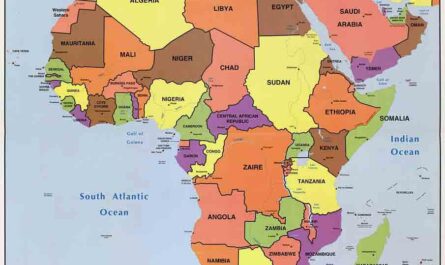What are some of the interesting facts about Angola? As Angola continues to navigate its path towards stability and prosperity, its people remain resilient, drawing strength from their cultural heritage and a shared sense of unity. Through efforts to promote education, healthcare, and infrastructure, Angola is shaping a brighter future for generations to come, determined to overcome its past and embrace the promise of tomorrow. In this article, I will talk about some interesting facts about Angola.
Nestled on the southwestern coast of Africa, Angola stands as a nation of diverse landscapes, rich cultural heritage, and a turbulent history marked by struggle and resilience. With its capital city Luanda serving as a bustling hub of commerce and culture, Angola is a country of contrasts, where modern skyscrapers stand in juxtaposition to traditional villages dotting the countryside. Its natural beauty spans from the lush rainforests of the north to the arid deserts of the south, offering a breathtaking tapestry of scenery for visitors and locals alike.
Interesting Facts About Albania: History, Culture, Travel
Angola’s history is deeply intertwined with colonialism, with Portuguese rule lasting for centuries until the country gained independence in 1975. However, this newfound freedom ushered in a period of civil unrest and conflict, leaving scars that are still healing today. Despite these challenges, Angola has made significant strides in recent years, particularly in economic development fueled by its vast reserves of oil and other natural resources. Here are some interesting facts about Angola:
1. Majestic Magnitude: Exploring Angola’s Land of Giants
As the seventh-largest country in Africa, Angola commands attention with its vast territory and diverse landscapes that stretch as far as the eye can see. From the arid expanses of deserts and savannas to the verdant embrace of lush rainforests, Angola’s majestic magnitude captivates the imagination and beckons adventurers to explore its untamed beauty.
Embark on an epic journey through Angola’s rugged terrain, where every step reveals a new marvel to behold. Traverse the rolling dunes of the Namib Desert, where towering sandscapes and shimmering mirages create an otherworldly panorama that stirs the soul. Venture into the heart of the Okavango Basin, where sprawling wetlands teem with life and the rhythmic chorus of wildlife echoes through the misty dawn.
2. Coastal Charms: Angola’s Atlantic Allure
Along Angola’s sprawling coastline, a world of wonder awaits, stretching over 1,600 kilometers and offering a tantalizing tapestry of pristine beaches and hidden coves. From the windswept shores of Benguela to the sun-kissed sands of Luanda, Angola’s Atlantic allure beckons travelers to discover a maritime paradise teeming with natural beauty and coastal charm.
Sink your toes into the soft sands of Angola’s beaches, where azure waters lap gently against rocky cliffs and golden shores. Dive beneath the surface to explore vibrant coral reefs and underwater ecosystems that harbor a kaleidoscope of marine life, from colorful fish to majestic sea turtles. Whether you’re seeking adventure on the high seas or tranquility on secluded shores, Angola’s coastline promises endless opportunities for exploration and discovery.
3. Colonial Legacy: Tracing Angola’s Colonial Echoes
Portugal’s colonial legacy looms large over Angola, shaping its language, architecture, and cultural practices in profound and lasting ways. From the arrival of Portuguese explorers in the 16th century to the tumultuous era of colonial rule that followed, Angola’s history bears the indelible imprint of European conquest and exploitation.
Explore the streets of Luanda, Angola’s capital city, where colonial-era architecture stands as a testament to the country’s complex past. Wander through bustling markets and historic neighborhoods, where the rhythms of daily life blend with echoes of bygone eras. Delve into Angola’s cultural heritage, where Portuguese influences mingle with indigenous traditions to create a vibrant tapestry of identity and expression.
4. Carnaval Costumes
In Angola, the carnival is a jubilant affair, marked by the flamboyant display of costumes and masks that encapsulate the spirit of celebration. These vibrant garments, adorned with intricate designs and adorned with feathers and beads, are a visual feast for the senses. The colors burst forth like a kaleidoscope, painting the streets with hues of red, yellow, blue, and green. Each costume tells a story, reflecting the rich tapestry of Angolan culture and history. From traditional attire honoring ancestral roots to modern interpretations that embrace contemporary trends, the carnival costumes are a reflection of the nation’s diversity and creativity.
The masks worn during the carnival are equally mesmerizing, crafted with meticulous detail to embody mythical beings, animals, and symbolic figures. They conceal the wearer’s identity, allowing them to immerse themselves fully in the festivities, transcending barriers of age, gender, and social status. Behind each mask lies a sense of mystery and intrigue, inviting onlookers to peer into the soul of Angolan tradition. As the music fills the air and the dancers move in rhythmic harmony, the carnival costumes transform the streets into a vibrant stage, where fantasies come to life and joy knows no bounds.
5. The Enchanting Black Stones of Pungo Andongo
Nestled near the town of Quibala, the majestic rock formations of Pungo Andongo stand as silent sentinels of time, casting a spellbinding aura over the landscape. These enigmatic geological wonders, resembling colossal black boulders, have long captured the imagination of locals and travelers alike. Rising from the earth like ancient guardians, they evoke a sense of awe and wonder, beckoning visitors to explore their rugged beauty.
Legend has it that Pungo Andongo was once the site of a fierce battle between two rival tribes, their conflict immortalized in the rocky terrain. Some believe that the stones are the petrified remains of warriors who fell in combat, while others see them as the handiwork of mythical beings, frozen in time for eternity. Regardless of their origin, the black stones exude a mystique that is both captivating and haunting, inviting contemplation and introspection.
6. Looking Ahead
As Angola strides confidently into the future, it stands poised to harness its vast potential and emerge as a prominent player on the African stage. Endowed with abundant natural resources and a rich cultural heritage, the nation possesses the building blocks for sustained growth and development. By prioritizing initiatives that promote education, healthcare, and economic empowerment, Angola can unlock the full potential of its people and pave the way for a brighter tomorrow.
Moreover, Angola’s strategic location and growing influence in regional affairs position it as a key player in Africa’s geopolitical landscape. By fostering partnerships with neighboring countries and global allies, Angola can leverage its resources and expertise to drive progress and prosperity across the continent. With visionary leadership and a commitment to inclusive governance, Angola can chart a course towards a future where opportunity knows no bounds, and the aspirations of its people are realized to the fullest extent.
7. Independence Achieved
In a tumultuous era marked by strife and upheaval, Angola’s journey to independence from Portuguese colonial rule in 1975 stands as a testament to the resilience and determination of its people. Enduring years of hardship and bloodshed, Angolans fought valiantly for their freedom, their struggle culminating in a historic moment of triumph and liberation.
The Declaration of Independence heralded a new dawn for the nation, signaling the end of centuries of foreign domination and the dawn of self-determination. Yet, the path to sovereignty was fraught with obstacles, and the scars of war would leave an indelible mark on Angola’s collective consciousness. Nevertheless, the spirit of independence forged in the crucible of conflict continues to inspire generations, reminding them of the price paid for the precious gift of freedom.
8. Mbundu Majority
At the heart of Angola’s cultural mosaic lies the Mbundu people, the largest ethnic group in the country, whose rich heritage and traditions have shaped the nation’s identity for centuries. With their ancestral roots firmly planted in the fertile soil of Angola’s heartland, the Mbundu have played a pivotal role in shaping the country’s history, politics, and culture.
Their language, Kimbundu, echoes through the bustling streets of urban centers and the quiet villages of the countryside, serving as a vibrant tapestry that binds communities together. Yet, alongside the Mbundu, Angola is home to a diverse tapestry of ethnic groups, each contributing its unique customs, languages, and beliefs to the nation’s rich cultural tapestry. Together, they weave a colorful tapestry of diversity, unity, and resilience that defines the Angolan spirit.
9. Oil Wealth and Challenges
In the sun-drenched plains of Angola lies a hidden treasure that has fueled the nation’s dreams of prosperity and progress: oil. Blessed with vast reserves of black gold, Angola has emerged as one of Africa’s leading oil producers, its petrodollars flowing steadily into the veins of its economy. Yet, beneath the veneer of wealth lies a complex web of challenges and contradictions. The oil boom has brought unprecedented riches to Angola’s coffers, but it has also exposed the fragility of its economy and the inequalities that divide its people.
Ensuring that this wealth translates into tangible benefits for all Angolans remains a formidable task, one that demands visionary leadership, transparent governance, and a commitment to sustainable development. As Angola grapples with the dualities of oil wealth, it stands at a crossroads, poised to harness its resources for the greater good or risk squandering them in the sands of time.
10. Diamond Deposits
Angola’s diamond deposits are a source of both wealth and controversy. Beneath its rugged terrain lie precious gems that have the potential to drive economic growth and prosperity. However, concerns linger regarding the ethical practices surrounding diamond mining in the country. Instances of exploitation, environmental degradation, and human rights violations have cast a shadow over the industry, prompting calls for greater transparency and accountability.
Despite these challenges, Angola has taken steps to regulate its diamond sector and promote responsible mining practices, recognizing the importance of sustainable development for the well-being of its people and the preservation of its natural heritage.
11. Lusophone Legacy
Angola’s ties to Portugal run deep, shaping its cultural identity and linguistic landscape. As a proud member of the Community of Portuguese Language Countries (CPLP), Angola is part of a global network that promotes linguistic and cultural exchange among Portuguese-speaking nations. This legacy of colonialism has fostered a unique bond among Lusophone countries, transcending geographical boundaries and fostering cooperation in areas such as education, trade, and diplomacy.
Through initiatives like the CPLP, Angola continues to strengthen its connections with its Portuguese-speaking counterparts, celebrating the richness of its shared heritage while embracing its own distinct cultural identity.
12. Religious Mosaic
Angola’s religious landscape is a vibrant tapestry woven with diverse beliefs and practices. While Christianity, particularly Catholicism, and Protestantism, holds sway as the dominant faiths, indigenous religions, and Islam also play significant roles in the spiritual fabric of the nation. Traditional beliefs, rooted in ancestral worship and animism, coexist alongside the teachings of Christianity, shaping the rituals and customs of Angolan society.
Likewise, the presence of Islam, introduced through trade and migration, adds another layer of diversity to Angola’s religious mosaic. Despite differences in doctrine and worship, the various faith traditions in Angola contribute to the country’s cultural richness and foster a spirit of tolerance and mutual respect among its people.
13. Luanda’s Remarkable Metamorphosis
Over the past few years, Luanda, the lively and bustling capital city of Angola, has experienced a profound and noteworthy transformation. The cityscape, once dominated by colonial-era architecture, now boasts a striking juxtaposition of modern infrastructure seamlessly intertwined with remnants of its historical past. Towering skyscrapers now stand proudly amidst the remnants of colonial buildings, symbolizing the city’s journey toward modernization while preserving its rich heritage.
The streets, once congested and chaotic, now exude a sense of order and efficiency, thanks to meticulous urban planning initiatives. Gleaming malls, state-of-the-art office complexes, and trendy cafes have sprung up across the city, catering to the evolving needs and tastes of its cosmopolitan populace. Luanda’s transformation serves as a testament to the resilience and adaptability of its people, who have embraced change while staying rooted in their cultural heritage.
14. The Magnificence of Angola’s Carnival
Angola’s carnival celebrations, particularly in the vibrant streets of Luanda, are nothing short of a spectacular extravaganza. Each year, as the carnival season approaches, the city comes alive with an explosion of color, music, and revelry. Elaborately adorned floats parade through the streets, accompanied by dancers clad in intricate costumes that reflect the diverse cultural tapestry of the nation.
The pulsating rhythms of traditional Angolan music reverberate through the air, enticing spectators to join in the festivities with abandon. From the intricately designed masks to the rhythmic gyrations of the dancers, every aspect of the carnival is a feast for the senses. Families gather to partake in the merriment, indulging in delicious street food and engaging in lively conversations amidst the cacophony of sounds. Angola’s carnival is not merely a celebration but a profound expression of the nation’s collective spirit, unity, and joie de vivre.
15. Semba: The Heartbeat of Angolan Culture
Semba, often hailed as the heartbeat of Angolan culture, occupies a revered place in the country’s musical landscape. This vibrant music genre, infused with elements of Portuguese and African influences, serves as a rhythmic expression of Angolan identity and heritage. Characterized by its infectious melodies, spirited rhythms, and soulful lyrics, Semba has captivated audiences both at home and abroad. The music’s origins can be traced back to the bustling streets of Luanda, where it emerged as a form of cultural expression among the Afro-Portuguese communities.
Over the years, Semba has evolved and diversified, incorporating elements of jazz, funk, and soul, while retaining its distinct Angolan flavor. From intimate gatherings to grand concert halls, Semba’s sway transcends social boundaries, bringing people together in celebration of life, love, and resilience. In the tapestry of Angolan culture, Semba shines as a radiant thread, weaving together the past, present, and future of a nation rich in musical heritage.

16. Cachaça: A Toast to Brazilian Spirit
In Angola, amidst lively gatherings and convivial atmospheres, Cachaça reigns supreme as a beloved beverage choice. Originating from Brazil, this sugarcane-derived spirit has found a fervent following among Angolan connoisseurs. Whether sipped neat to savor its intricate flavors or mixed into tantalizing cocktails, Cachaça embodies the spirit of camaraderie and celebration.
Its versatility lends itself to a myriad of concoctions, from classic Caipirinhas to innovative twists crafted by skilled mixologists. With each sip, Cachaça transports the imbiber on a sensory journey, evoking visions of sun-kissed beaches and rhythmic samba beats. In bars and homes alike, the clinking of glasses filled with this amber elixir resonates with laughter and shared memories, making every toast a moment to cherish.
17. Muxama: A Culinary Masterpiece
Muxama, a culinary gem in Angola’s gastronomic repertoire, delights the palate with its savory allure. This delicacy, crafted from sun-dried and salted fish, boasts a distinctive flavor profile that tantalizes the taste buds. From its humble origins as a preservation method to its elevated status as a national specialty, Muxama embodies the ingenuity and resourcefulness of Angolan cuisine. Each bite offers a symphony of textures and tastes, from the firm yet tender flesh to the nuanced interplay of salt and umami notes. Whether enjoyed as a standalone appetizer or incorporated into traditional dishes, Muxama leaves a lasting impression, leaving diners craving for more of its gastronomic brilliance.
18. Kissanje: A Journey Through Time
Nestled amidst Angola’s diverse landscape, Kissanje stands as a testament to the country’s rich tapestry of history and culture. As the second-largest city, it serves as a captivating blend of colonial charm and contemporary vibrancy. Strolling through its streets, one is greeted by a captivating array of colonial architecture, harkening back to a bygone era of exploration and conquest.
The bustling markets, teeming with life and activity, offer a glimpse into the daily rhythms of Angolan life, where commerce and culture intersect. Each corner reveals a new facet of Kissanje’s allure, from its cultural landmarks to its culinary delights. Amidst the hustle and bustle, there lingers a sense of nostalgia and wonder, inviting visitors to immerse themselves in the city’s rich tapestry of sights, sounds, and flavors.
19. The Majestic Congo River: Lifeline of Angola
The Congo River, a colossal natural wonder, carves its path along Angola’s northern border, bestowing upon the land a vital lifeline of water resources and transportation routes. As it meanders through the lush landscape, its mighty waters sustain ecosystems teeming with diverse flora and fauna, enriching the region’s biodiversity. Beyond its ecological significance, the Congo River serves as a bustling thoroughfare, facilitating trade and commerce between Angola and its neighboring nations.
Its navigable waters have long been a conduit for the exchange of goods and cultures, fostering connections that transcend geographical boundaries. From the bustling port cities that dot its banks to the tranquil villages nestled along its shores, the Congo River weaves a narrative of resilience, adaptability, and interconnectedness that defines Angola’s northern frontier.
20. Bwé Caves: Windows to the Past
In the southwestern reaches of Angola, the Bwé Caves stand as silent sentinels of a bygone era, housing within their ancient chambers a treasure trove of prehistoric marvels. Adorned with intricate rock paintings dating back thousands of years, these caverns offer a tantalizing glimpse into the lives and customs of early Angolans. Each brushstroke on the cave walls tells a story, depicting scenes of hunting, gathering, and communal rituals that once echoed through the primordial forests.
The delicate artistry preserved within these subterranean galleries serves as a testament to the ingenuity and creativity of Angola’s earliest inhabitants, providing invaluable insights into their cultural heritage and worldview. As visitors traverse the dimly lit passages, they are transported back in time, forging a tangible connection to the distant past and the enduring legacy of those who came before.
21. Namib Desert’s Silent Advance
In the southwestern expanse of Angola, the Namib Desert, a vast expanse of arid beauty, casts its shadow over the land, its sandy fingers inching ever closer with each passing year. As one of the world’s oldest deserts, the Namib exerts a quiet yet inexorable influence, its shifting dunes and barren plains reshaping the landscape with timeless patience. Slowly but steadily, the desert encroaches upon Angola’s southwestern region, posing a formidable challenge to ecosystems and communities alike.
The relentless advance of sand threatens to engulf fertile farmlands and disrupt delicate ecological balances, prompting efforts to mitigate its impact through sustainable land management practices. Despite the desert’s formidable presence, there exists a profound beauty in its starkness, a testament to nature’s capacity for both destruction and renewal. As Angola grapples with the encroaching sands of the Namib, it stands as a testament to the resilience and resourcefulness of its people in the face of adversity.
22. Angola’s Ecological Riches: A Haven for Wildlife
Angola’s expansive landscapes harbor a treasure trove of biodiversity, showcasing a dazzling array of wildlife that spans from the lush savannas to the pristine coastlines. Majestic elephants roam the sun-drenched plains alongside regal lions, their presence a testament to the country’s wild splendor. In the dense forests, unique primates swing from branch to branch, their playful antics a testament to the intricate web of life that thrives in Angola’s verdant heartland. Along the rugged coastline, vibrant marine ecosystems teem with life, from colorful fish darting among coral reefs to graceful marine mammals gliding through azure waters. Angola’s diverse wildlife serves as a poignant reminder of the importance of conservation efforts in safeguarding the natural heritage of the nation for future generations to cherish and protect.
23. Kissama National Park: A Sanctuary of Serenity
Nestled within Angola’s picturesque landscapes, Kissama National Park beckons adventurers and nature enthusiasts alike to immerse themselves in the splendor of the wild. Spread across vast plains and rolling hills, the park offers a sanctuary for a diverse array of wildlife, including towering giraffes, majestic zebras, and graceful antelope species. As visitors traverse its untamed terrain, they are treated to awe-inspiring encounters with nature’s most magnificent creatures, their presence a testament to the park’s commitment to conservation and preservation. From thrilling game drives to tranquil bush walks, Kissama National Park invites travelers to forge a deeper connection with the natural world and embark on a journey of discovery amidst the splendor of Angola’s wilderness.
24. Cabo Ledo: Riding the Waves of Adventure
For thrill-seekers and surf aficionados, Cabo Ledo stands as a beacon of adventure on Angola’s sun-kissed shores. Located just south of the bustling metropolis of Luanda, this idyllic coastal enclave boasts some of the most consistent waves and challenging breaks in the region, making it a paradise for wave riders of all skill levels. Surrounded by rugged cliffs and golden sands, Cabo Ledo offers an unparalleled setting for adrenaline-fueled escapades and laid-back beachfront relaxation. Whether carving through the waves or lounging in the sun-kissed sands, visitors to Cabo Ledo are sure to find bliss amidst the breathtaking beauty of Angola’s coastal paradise.
25. Coffee Culture: Angola’s Liquid Gold
In the fertile lands of Angola, coffee reigns supreme as a prized agricultural commodity, with its cultivation playing a pivotal role in the nation’s economy. Blessed with rich volcanic soils and favorable climatic conditions, Angola’s coffee plantations thrive, particularly in the highlands where Robusta beans flourish. The journey from bean to brew is a testament to the dedication and expertise of local farmers, who meticulously tend to their crops with care and precision.
As the sun rises over verdant fields, workers labor tirelessly to harvest the ripe cherries, signaling the beginning of a meticulous process of sorting, roasting, and grinding. From bustling markets to cozy cafes, the aroma of freshly brewed coffee permeates the air, enticing connoisseurs and casual drinkers alike to savor the rich flavors and complex aromas of Angola’s liquid gold.
26. Building Bridges: Angola’s Path to Peace
In the wake of a protracted civil war that ravaged the nation for decades, Angola has embarked on a journey of healing and reconciliation, striving to forge a path towards lasting peace and stability. While significant strides have been made in the pursuit of peace, formidable challenges remain in the arduous task of rebuilding infrastructure and fostering development in war-torn regions.
From the bustling streets of urban centers to the tranquil villages nestled amidst verdant hills, signs of progress and resilience abound as communities come together to chart a brighter future. Through dialogue, cooperation, and a shared commitment to national unity, Angola stands poised to overcome the scars of its past and embrace a future defined by hope, prosperity, and collective prosperity.
27. Soccer Fever: Angola’s Sporting Obsession
In Angola, the heartbeat of the nation pulses to the rhythm of football, the most beloved and passionately followed sport across the land. From dusty playgrounds to gleaming stadiums, the passion for the beautiful game unites people of all ages and backgrounds, transcending boundaries and fostering a sense of camaraderie and national pride. The national team, affectionately known as the Palancas Negras, commands unwavering support from legions of fervent fans, who rally behind their heroes with unwavering loyalty and fervor.
Beyond the international stage, football holds a special place in local communities, where grassroots leagues and tournaments serve as vibrant hubs of social interaction and friendly competition. As the cheers of spectators reverberate through the air and the thrill of victory ignites hearts and minds, football emerges as more than just a sport—it is a cultural phenomenon that binds the fabric of Angolan society together in a shared celebration of passion, skill, and unity.
28. The Splendor of Quiçama National Park
Nestled along the picturesque Angolan coast, Quiçama National Park stands as a bastion of biodiversity, safeguarding a diverse array of wildlife within its pristine boundaries. From the majestic black rhinos to the playful chimpanzees swinging through the verdant canopy, the park is a haven for countless species that call it home. Along the sandy shores, marine turtles nestle in the warm sands, their ancient rituals echoing the timeless rhythms of nature.
As visitors traverse the park’s rugged terrain, they are treated to awe-inspiring encounters with some of Africa’s most iconic creatures, their presence a testament to the park’s commitment to conservation and preservation. From thrilling safari adventures to serene birdwatching excursions, Quiçama National Park offers a sanctuary for both wildlife and nature enthusiasts alike, inviting all who enter to immerse themselves in the splendor of Angola’s natural heritage.
29. Angola’s Linguistic Mosaic
In the vibrant tapestry of Angolan culture, language serves as a cornerstone of identity and expression, reflecting the nation’s rich diversity and heritage. While Portuguese holds the mantle of the official language, Angola is a melting pot of linguistic traditions, with Bantu languages such as Kimbundu and Umbundu spoken by significant portions of the population. Each language carries with it a unique cadence and character, rooted in centuries of history and cultural exchange. Business – Money Making – Marketing – E-commerce
From the bustling markets of urban centers to the tranquil villages nestled amidst rolling hills, the symphony of voices resonates with the melodies of myriad tongues, weaving a narrative of unity amidst diversity. As Angolans embrace their multilingual heritage with pride, language becomes a bridge that connects people across regions and generations, fostering understanding and solidarity in the tapestry of national identity.
30. Artistry in Basket Weaving
In Angola, the ancient art of basket weaving transcends mere craft, embodying a cherished tradition passed down through generations with love and reverence. From the fertile valleys to the bustling cities, skilled artisans deftly weave together natural materials to create exquisite baskets of unparalleled beauty and intricacy. Each basket tells a story, its intricate patterns and vibrant colors reflecting the landscape, culture, and traditions of the region from which it hails.
From practical containers for everyday use to intricate works of art destined for display, Angolan baskets serve as tangible expressions of creativity and craftsmanship. Beyond their aesthetic appeal, these woven treasures hold deeper significance, symbolizing community, heritage, and the timeless bond between humanity and nature. As Angolans continue to preserve and celebrate their rich basket-weaving heritage, they weave a legacy that honors the past while embracing the future with open arms.



